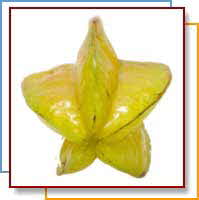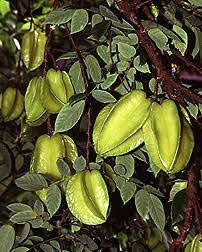Home | FOOD ARTICLES | Food Trivia | Today_in_Food_History | Food_History_Timeline | Recipes | Cooking_Tips | Food_Videos | Food_Quotes | Who’s_Who | Culinary_Schools_&_Tours | Food_Trivia_Quizzes | Food_Poems | Free_Magazines | Food_Festivals_and_Events
Food Articles, News & Features Section
FREE Magazines
and other Publications
Free Professional and Technical Research, White Papers, Case Studies, Magazines, and eBooks
STAR FRUIT - Carambola
Description
The star fruit or carambola (Averrhoa carambola*) is a unique tropical fruit that is gaining popularity in the United States. This fruit acquired its name from the five pointed star shape** when cut across the middle (occasionally 4 or 6 ribbed fruit may occur). The 3 to 5 inch long fruit has a paper-thin thin, translucent, waxy, yellow-orange to green skin with tart crisp flesh.

Star fruit range in taste from pleasantly tart and sour to slightly sweet with a complicated flavor combination that includes plums, pineapples, and lemons. The flesh is juicy and crunchy, and may be eaten skin, seeds and all or used as a garnish, in salads and in relishes and preserves. When used in cooking, green fruit are frequently used for their sourness. The juicy flesh is mostly water and does not hold up well when heated.
* Carambola: Named after Averrhoës [Ibn Rushd], a 12th century Muslim philosopher and physician. Carambola is a Portuguese word derived from a South Indian language).
** Another fruit with a similar shape is the Babaco or Mountain Papaya.
See also: Star Fruit Trivia
History

Although it is not now found in the wild, the star fruit is originally native to Sri Lanka and the Moluccas, and has been cultivated in Southeast Asia and Malaysia for almost 1,000 years. It is known many other names including: ‘belimbing’ or ‘belimbing manis’ (Indonesia), ‘mafueng’ (Thailand), ‘kamrakh’ (Indian) Chinese starfruit, star apple and Five angled fruit. Today they are also grown throughout the Caribbean, Central and South America, Florida and Hawaii because the fruit thrives on growing in a warm environment.
A member of the Oxalis (wood sorrel) family, star fruit grow on a bushy tree 25 to 30 feet high with a spread of 20 to 25 feet. The leaves are sensitive to touch and light, folding up at night or when touched. The fragrant flowers are pink to lavender in color, about 3/8 inch in diameter. The fruits grow in groups of 3 or 4 on the branches and trunk of the tree and the trees produce fruit for up to 40 years. They are non-seasonal and produce 3 to 5 crops each year.
Varieties
Two varieties are found in markets, one sour and the other slightly sweet. Their flavor is sometimes described as like a cross between an apple and a grape. It is almost impossible to tell the sweet and tart varieties apart, but in general the tart varieties have narrowly spaced ribs and sweet varieties have thicker, fleshier ribs; some also report that the yellower, the sweeter. The tastes between the two are hardly distinguishable, as the tart variety still has some sweetness. There are several white varieties, all of which are sweet.
This tropical fruit is readily available July through February.
Star fruit are an excellent source of vitamin C, is low fat, and naturally sodium and cholesterol free. A small whole fruit will provide approximately 2/3 cup sliced.
Traditional Medicinal Uses
Preparations of the leaves and roots have been used to cure headaches, hangovers, sore eyes, ringworm, prickly heat and chickenpox. Given to nursing mothers it is believed to stimulate the flow of milk.
Selection
Select firm, shiny skinned, even colored fruit. They will ripen at room temperature and have lightly brown edges on the ribs and a full fruity aroma when ripe. Avoid purchasing fruit with brown, shriveled ribs. This delicious fruit is also available dried.
Storage
Star fruit bruise easily, so handle with care. Non-ripe fruit should be turned often, until they are yellow in color and ripe with light brown ribs. Store ripe fruit at room temperature for two to three days or unwashed, and refrigerated, in a plastic bag for up to one to two weeks.
Preparation & Use
They are great to eat out of hand as these tropical delights do not need to be peeled or seeded before eating. Simply wash the fruit, remove any blemished areas, cut crosswise to get the star shape, and eat.
The sweet variety can be eaten out of hand or sliced and used as a garnish or in salads. They are also used in chutney, curries and tarts. The juice can be used in tropical drinks and smoothies.
 Make Star Fruit Part of Your 5 A Day Plan
Make Star Fruit Part of Your 5 A Day Plan
-- Add to fruit salads.
-- Use for tarts, preserves, chutney and stewed fruits.
-- Garnish chicken, pork or fish dishes.
-- Garnish beverages.
-- Add to your fruit smoothies.
STAR FRUIT NUTRITION
Serving size 125g - Amounts Per Serving - % Daily Value*
Calories 40
Calories from Fat 5
Total Fat 0g - 0%
Saturated Fat 0g - 0%
Cholesterol 0mg - 0%
Sodium 0mg - 0%
Total Carbohydrate 10g - 3%
Dietary Fiber 3g - 12%
Sugars 7g
Protein 1g
Vitamin A 15%
Vitamin C 45%
Calcium 0%
Iron 2%
* Percent Daily Values are based on a 2,000 calorie diet.
IMPORTANT NOTE:
This danger appears to be limited to individuals with very specific medical conditions.
Starfruit originated in Southeast Asia and is readily available in Taiwan. They cause several symptoms in patients with chronic renal failure or end-stage renal disease. The symptoms vary and include insomnia, intractable hiccups, agitation, muscle weakness, confusion, consciousness disturbances of various degrees, seizures, and cardiorespiratory arrest. The various subspecies contain different toxins, including a powerful neurotoxin that is suspected to accumulate in blood, cross the blood-brain barrier in chronic renal failure patients, and eventually cause irreversible damage.
Star fruit intoxication is a neglected but serious fruit intoxication frequently observed in patients with chronic renal failure. Because no effective treatment is currently available, patients— especially those who are newly diagnosed with chronic renal failure or end-stage renal disease—must be warned not to ingest the fruit, even in small amounts.
RELATED ARTICLES
Please feel free to link to any pages of FoodReference.com from your website.
For permission to use any of this content please E-mail: james@foodreference.com
All contents are copyright © 1990 - 2026 James T. Ehler and www.FoodReference.com unless otherwise noted. All rights reserved.
You may copy and use portions of this website for non-commercial, personal use only.
Any other use of these materials without prior written authorization is not very nice and violates the copyright.
Please take the time to request permission.

